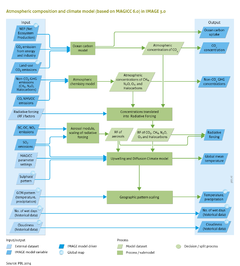Atmospheric composition and climate/Policy issues: Difference between revisions
Jump to navigation
Jump to search
m (Text replace - "Overmars et al. (unpublished)" to "Overmars et al., accepted") |
No edit summary |
||
| Line 1: | Line 1: | ||
{{ComponentPolicyIssueTemplate | {{ComponentPolicyIssueTemplate | ||
|Reference=Overmars et al., accepted; Van Vuuren and Stehfest, 2013; Shindell et al., 2012; | |Reference=Overmars et al., accepted; Van Vuuren and Stehfest, 2013; Shindell et al., 2012; | ||
|Description= | |Description=In baseline scenarios, emissions and greenhouse gas concentrations increase substantially. The increase in emissions depends on socio-economic factors, such as population growth, economic growth, technology development and lifestyle. Most medium baseline scenarios in IMAGE result in a rise in global mean temperature of about 3 to 5 °C above pre-industrial levels by 2100 (Figure below). | ||
|Example=Policy interventions that affect future climate range from policy on energy and agricultural systems, air pollution measures, and land-use policies to direct management of radiative forcing. For instance, the IMAGE system can be used to analyse energy efficiency, use of low-carbon fuels, reduction in non-CO2 greenhouse gas emissions and reduction of deforestation ([[Overmars et al., accepted]]). Interventions related to policies on climate, air pollution and land use are described in [[Climate policy]], [[Air pollution and energy policies]] and [[Land and biodiversity policies]]. These measures lead to a change in emissions, and then to the expected reduction in radiative forcing and climate change. | |Example=Policy interventions that affect future climate range from policy on energy and agricultural systems, air pollution measures, and land-use policies to direct management of radiative forcing. For instance, the IMAGE system can be used to analyse energy efficiency, use of low-carbon fuels, reduction in non-CO2 greenhouse gas emissions and reduction of deforestation ([[Overmars et al., accepted]]). Interventions related to policies on climate, air pollution and land use are described in Componens [[Climate policy]], [[Air pollution and energy policies]] and [[Land and biodiversity policies]], respectively. These measures lead to a change in emissions, and then to the expected reduction in radiative forcing and climate change. | ||
The slow temporal dynamics of the climate system play an important role in climate policy assessments. IMAGE calculations show considerable time lag between policy introduction and impacts on climate change. Even if emissions were substantially reduced from 2020 and onwards, several decades would elapse before | The slow temporal dynamics of the climate system play an important role in climate policy assessments. IMAGE calculations show considerable time lag between policy introduction and impacts on climate change. Even if emissions were substantially reduced from 2020 and onwards, several decades would elapse before stabilization in temperature in the global climate system is observed (Figure above). In addition to these standard climate measures, a range of policy interventions may play a role in the temporal dynamics of the climate system, and may be analysed using the IMAGE system: | ||
* Mitigation in short-lived versus long-lived greenhouse gas emissions, and co-benefits with air pollution measures ([[Shindell et al., 2012]]). Short-term benefits in air quality and climate mitigation may be achieved by reducing black carbon emissions and ozone precursors. | |||
[[ | * Non-mitigation management of global radiative forcing, such as by means of geo-engineering as shown in Figure below ([[Van Vuuren and Stehfest, 2013]]). | ||
See also the Policy interventions Table below | |||
}} | }} | ||
Revision as of 19:21, 20 May 2014
Parts of Atmospheric composition and climate/Policy issues
| Component is implemented in: |
|
| Related IMAGE components |
| Projects/Applications |
| Models/Databases |
| Key publications |
| References |
